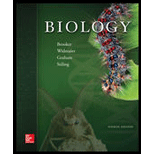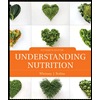
Biology
4th Edition
ISBN: 9781259188121
Author: Peter Stiling, Robert Brooker, Linda Graham, Eric Widmaier
Publisher: McGraw-Hill Education
expand_more
expand_more
format_list_bulleted
Concept explainers
Question
Chapter 3.4, Problem 1BC
Summary Introduction
To explain: The conclusions that may be drawn about the abundance of cellulose on earth.
Introduction: Polysaccharides are composed of monosaccharide sugars. These sugars are linked together by glycosidic bonds. Polysaccharides are of two types: branched and non-branched based on the linking of their monomers. There are different polysaccharide molecules present, for example, glycogen is a disaccharide molecule composed of long chains of glucose monomers. Cellulose is a polysaccharide of β-D- glucose. Cellulose is an unbranched polysaccharide molecule.
Expert Solution & Answer
Want to see the full answer?
Check out a sample textbook solution
Students have asked these similar questions
Experiment 1: Functional properties of starch in a food product There is wide within-species variation in starch content and composition. Rice can vary from “waxy” types with virtually no amylose in the starch to “normal” types with perhaps 20% amylose. Desserts made from different types of rice flour have very different properties, especially texture.
Materials: Two types of rice flour (soaked in 64 ml of water) • Glutinous (waxy, 1% amylose) • Non-glutinous Sugar (finely granulated) Baking powder Salt Procedure: 64 g each 25 g 1 g 0.5 g Laboratory 1 Properties of Starch Starch is made up of amylose and amylopectin in various proportions. Because amylose and amylopectin have very different physicochemical properties, the types of starch and thus the amylose to amylopectin ratio significantly affects the sensory characteristics, especially the texture of food products.
Objective: To compare the texture of steamed dessert made from glutinous and non- glutinous rice flour
Procedures:
1.…
Can someone help me please
Describe the biological advantage of storing glucose units in branched polymers rather than linear polymers.?
Profile picture for
← Biology Texas (2015
POSTTEST: Chemistry of Life
Fructose, a component of sucrose, and ribose, a component of nucleic
acid, have very similar structures.
How do they differ?
O
CH₂OH
K
ge
OH
OH
CH₂OH
OH
Copyright © 2022 Apex Learning Inc.
Ribose
OH
ОН
OH
Fructose
CH₂OH
1 dl 8 QUESTIONS
Fructose is used for structural support in the cell, while ribose is used for
long-term energy storage.
Fructose is used to build up proteins, while ribose is used as a stabilizer
in plasma membranes.
Fructose is used for short-term energy storage, while ribose helps produce
proteins.
Chapter 3 Solutions
Biology
Ch. 3.4 - Prob. 1CCCh. 3.4 - What type of reaction is the reverse of the one...Ch. 3.4 - Prob. 1BCCh. 3.5 - Prob. 1CCCh. 3.5 - Prob. 2CCCh. 3.6 - How many water molecules would be produced during...Ch. 3.6 - Prob. 2CCCh. 3.6 - Prob. 1EQCh. 3.6 - Prob. 2EQCh. 3.6 - CoreSKILL Explain the result that was crucial to...
Ch. 3.7 - Prob. 1CCCh. 3 - Molecules that are found in living cells and...Ch. 3 - The versatility of carbon that allows it to serve...Ch. 3 - Prob. 3TYCh. 3 - Prob. 4TYCh. 3 - Prob. 5TYCh. 3 - In contrast to other fatty acids, essential fatty...Ch. 3 - Prob. 7TYCh. 3 - The monomers of proteins are ___________, and...Ch. 3 - Prob. 9TYCh. 3 - Prob. 10TYCh. 3 - Explain the similarities and differences between...Ch. 3 - Prob. 2CQCh. 3 - Prob. 3CQCh. 3 - Discuss the differences between the various types...Ch. 3 - Prob. 2COQ
Knowledge Booster
Learn more about
Need a deep-dive on the concept behind this application? Look no further. Learn more about this topic, biology and related others by exploring similar questions and additional content below.Similar questions
- Q3. Péclet number - We've seen the Péclet number Pé : vl as a useful metric to determine if stirring (Pé > 1) is more efficient than diffusion (Pé < 1) for mixing solutions. "Stirring" here can designate any process which applies a force on the molecules, resulting in a velocity v. a) Show that the Péclet number, like the Reynolds number, is unitless. Let's think about why scale (l) matters for mixing. A-DNA, a DNA polymer containing 48,502 base pairs, has a diffusion coefficient of D = field of 1 V/m, we can expect 1-DNA to reach a terminal velocity of 30 nm/s. 6.4 x 10-13m²s-1. Under an electric b) Find the Péclet number for a system of dimension of l = 10 cm. This corresponds to the scale of most benchtop instruments used to manipulate or separate biomolecules.arrow_forwardBiomechanically, what is the significance and importance of momentum when performing a regular glute bridge?arrow_forwardSimplified diagrams of macromolecules are given. What is the function of the molecule of diagram C? ос-с-с-с-с-с О-с-с-с-С-С-с б-с-с-с-с-С-С (d) (c) A Store energy for future use. B Carry genetic information. C Act as an enzyme in chemical reactions. D Provide "quick energy' for cells. C)arrow_forward
- Practice Performance Task: Cellulase PRACTICE PERFOR K Both humans and cows are able to consume plant matter made up of complex carbolydrates, such as starch or cellulose. However, a cow's digestive system is very different from that of a human. As a result, humans and cows differ in their ability to extract nutrients from plant-based food resources For example, unlike humans, vows can thrive on grass, which is largely made up of cellulose Cows are able to digest grass thanks to a complex community of microbes, inchading bacteria, in their digestive system. These bacteria prodoce cellulase, which starts the process of breaking down cellulose into smaller sobbunits of ghacose. Cows then acquire energy as the microbes in their digestive system utilize the glucose to carry out fermentation. A by-product of fermentation by bacteria is methane gas (CH,) 1. A student is working on drawing and labeling a very basic model showing how cellulose is broken down. The students work on the model so…arrow_forwardSAMSUNG 4 Assignment Question (Chemistr x A 01-2021-FSCBIO124-Biology1-A X high school years - Google Sear x e.com/file/d/1mawGqo2tZnOiFPc7w0Gpr1VyRRMpNInM/view QUESTION 1 Water potential is the pressure exerted by freely moving water molecules in a system. Describe the relationship between water potential with solute potential and pressure potential in plants. Plant cell P has a solute potential of-350 kPa and a pressure potential of 200 kPa. Besides, is plant cell Q which has a solute potential of -500 kPa and a pressure potential of 200 kPa. Determine the direction of net movement of water between the two cells by using the water potential equation. Explain the characteristics of water that make it such an important medium for life. If an athlete was heavily perspiring after an intense match game, suggest one type of replacement drink (with explanation) that he should take between hypertonic, isotonic and hypotonic drink to recover himself. 83°F へ ) F4 F5 F6 F7 F8 F9 F10 F11 F12 24…arrow_forwardQ1 What is the difference between reducing and non-reducing sugars? Q2 What is Sorbitol?arrow_forward
- Explain Why and How Questions???Give the reasons and examples!!Add Structures too! 1- Most isomerization’s states are seen in sugars?2- GLUT are many types and functions?arrow_forwardAcross 14. are organic compounds used to store and release energy 2. a polysaccharide with highly branched chains of glucose units, used by animals to 15. are organic compounds commonly called store food fats and oils Down 1. is a polysaccharide made of glucose units hooked together found in plant cell walls is a simple one-unit sugar such as glucose or fructose having the formula CH,206 9. are the small building blocks of polymers 10. are the largest carbohydrate molecules, they are polymers composed of many monosaccharides linked together (starch, glycogen, chitin, etc.) 3. 11. are macromolecules such as DNA and RNA 4. 12. are protein catalysts that speed up the rate of a chemical reactions in the body is a polysaccharide consisting of highly branched chains of glucose units used as food storage in plants 13. are the building blocks or subunits of proteins contains the elements carbon, hydrogen, oxygen, and nitrogen and is composed of 5.arrow_forwardB14U A Goals n Skills Minds On Actio O Connect 2 Choose any two words in the table below, then connect them with a complete idea. Repeat this process three times in total. monomer disaccharide glucose cell wall energy structure glycosidic bond isomer cell-to-cell communication For example: if the two words are ribosome and protein, then you could write: Ribosomes are connected to proteins because the ribosomes are the protein builders in the cell. Ribosomes are made of two parts or subunits. The larger of the 2 parts is where the ribosome can add on an amino acid to the growing protein chain. Practice good Organization skills by reviewing concepts and vocabulary from the whole Activity to include full details. Choose your best idea and share it with your classmates. Join The Discussionarrow_forward
- Feedback See Periodic Table Which of the following correctly describe both a lectin and a glycoprotein array? Choose one or more: A. can be used to determine the structure of glycan groups B. can be used to identify interactions between lectins and glycans C. can be used to detect interactions between glycans and antibodies D. can be used with more than one type of biological sample (e.g., glycoproteins and bacteria)arrow_forwardChemistry • Outline the biosynthesis of tuberculostearic acid using phospholipid-bounded oleic acid and SAM as starting reagents. + OPL AdR PL-bounded Oleic acid 18:1 (9c) PL = phospholipid %3D OPL tuberculostearic acidarrow_forwardBIO 340 Activity # 2: Understanding and constructing trees Name (Last, First): 1) Match the following components of a rooted tree with the respective letter: Recent Past B Feathers Hair Gizzard Cellular Cellular with a nucleus Nucleic acid genetic material C 2) Based on the information of the following table: Feathers Hawk + + + + + Gizzard Created by Dr. Susan A. Holechek for BIO 340 (2023) Mouse + + + A + + 3 Hair D Tree + + + Branches Terminal nodes Root Internal nodes E.coli Cellular + + Jaws Complete the following tree. Rectangles indicate where the species from the table should be located (one rectangle per species). Dotted lines indicate missing characteristics/features (refer to the table). Monkeypox Nucleic acid genetic material + T. rex + + + + +arrow_forward
arrow_back_ios
SEE MORE QUESTIONS
arrow_forward_ios
Recommended textbooks for you
 Biology (MindTap Course List)BiologyISBN:9781337392938Author:Eldra Solomon, Charles Martin, Diana W. Martin, Linda R. BergPublisher:Cengage Learning
Biology (MindTap Course List)BiologyISBN:9781337392938Author:Eldra Solomon, Charles Martin, Diana W. Martin, Linda R. BergPublisher:Cengage Learning Understanding Nutrition (MindTap Course List)Health & NutritionISBN:9781337392693Author:Eleanor Noss Whitney, Sharon Rady RolfesPublisher:Cengage Learning
Understanding Nutrition (MindTap Course List)Health & NutritionISBN:9781337392693Author:Eleanor Noss Whitney, Sharon Rady RolfesPublisher:Cengage Learning

Biology (MindTap Course List)
Biology
ISBN:9781337392938
Author:Eldra Solomon, Charles Martin, Diana W. Martin, Linda R. Berg
Publisher:Cengage Learning

Understanding Nutrition (MindTap Course List)
Health & Nutrition
ISBN:9781337392693
Author:Eleanor Noss Whitney, Sharon Rady Rolfes
Publisher:Cengage Learning